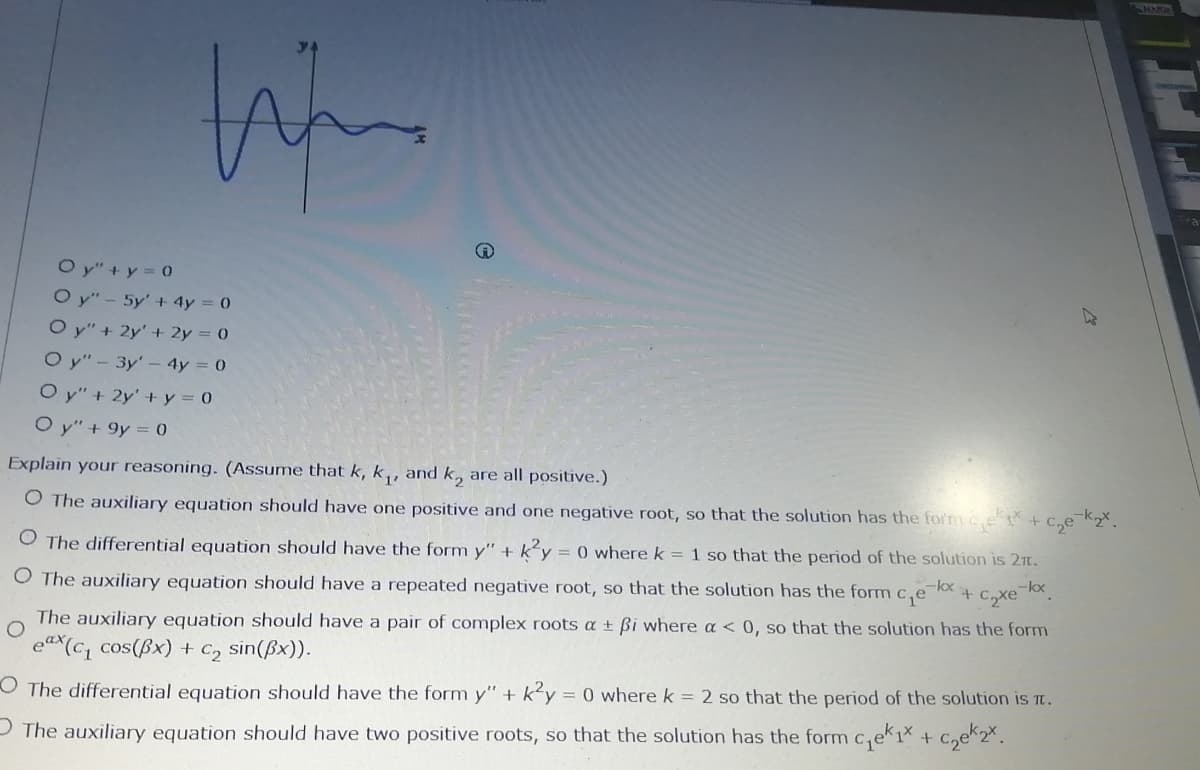O y" + y 0 O y" - 5y' + 4y = 0 O y" + 2y' + 2y = 0 O y" - 3y' - 4y = 0 O y" + 2y' + y = 0 O y" + 9y = 0 Explain your reasoning. (Assume that k, k,, and k, are all positive.) O The auxiliary equation should have one positive and one negative root, so that the solution has the form ce p + C,e¯Kz*. O The differential equation should have the form y" + k²y = 0 where k = 1 so that the period of the solution is 21t. -lox -kx O The auxiliary equation should have a repeated negative root, so that the solution has the form c,e + C,xe k. The auxiliary equation should have a pair of complex roots a t ßi where a < 0, so that the solution has the form ea(c, cos(ßx) + c, sin(ßx)). The differential equation should have the form y'" + k
O y" + y 0 O y" - 5y' + 4y = 0 O y" + 2y' + 2y = 0 O y" - 3y' - 4y = 0 O y" + 2y' + y = 0 O y" + 9y = 0 Explain your reasoning. (Assume that k, k,, and k, are all positive.) O The auxiliary equation should have one positive and one negative root, so that the solution has the form ce p + C,e¯Kz*. O The differential equation should have the form y" + k²y = 0 where k = 1 so that the period of the solution is 21t. -lox -kx O The auxiliary equation should have a repeated negative root, so that the solution has the form c,e + C,xe k. The auxiliary equation should have a pair of complex roots a t ßi where a < 0, so that the solution has the form ea(c, cos(ßx) + c, sin(ßx)). The differential equation should have the form y'" + k
Algebra for College Students
10th Edition
ISBN:9781285195780
Author:Jerome E. Kaufmann, Karen L. Schwitters
Publisher:Jerome E. Kaufmann, Karen L. Schwitters
Chapter13: Conic Sections
Section13.1: Circles
Problem 48PS
Related questions
Question
What is the solution curve

Transcribed Image Text:MARR
O y" + y = 0
O y" - 5y' + 4y = (0
O y" + 2y' + 2y = 0
O y" - 3y' – 4y = 0
O y" + 2y' + y = 0
O y" + 9y = 0
Explain your reasoning. (Assume that k, k,, and k, are all positive.)
O The auxiliary equation should have one positive and one negative root, so that the solution has the form ce pX + C,e¯Kz*.
O The differential equation should have the form y" + k´y
= 0 where k = 1 so that the period of the solution is 21t.
-kx
O The auxiliary equation should have a repeated negative root, so that the solution has the form c,e
+ C,xe kx.
The auxiliary equation should have a pair of complex roots a ± ßi where a < 0, so that the solution has the form
ea(c, cos(ßx) + c, sin(ßx)).
O The differential equation should have the form y" + k<y =0 where k = 2 so that the period of the solution is Tt.
P The auxiliary equation should have two positive roots, so that the solution has the form c,e1* + c,e%2*.
Expert Solution
This question has been solved!
Explore an expertly crafted, step-by-step solution for a thorough understanding of key concepts.
Step by step
Solved in 2 steps with 1 images

Recommended textbooks for you

Algebra for College Students
Algebra
ISBN:
9781285195780
Author:
Jerome E. Kaufmann, Karen L. Schwitters
Publisher:
Cengage Learning

Algebra & Trigonometry with Analytic Geometry
Algebra
ISBN:
9781133382119
Author:
Swokowski
Publisher:
Cengage

Algebra for College Students
Algebra
ISBN:
9781285195780
Author:
Jerome E. Kaufmann, Karen L. Schwitters
Publisher:
Cengage Learning

Algebra & Trigonometry with Analytic Geometry
Algebra
ISBN:
9781133382119
Author:
Swokowski
Publisher:
Cengage